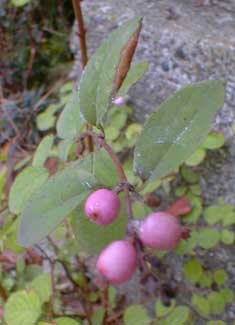
'Amethyst'
Purple Coralberry
"I took off my finery of pearls & coral,
and strung a garland of wildwood flowers."
-Mirabai
(1498-1546)
(1498-1546)
Although this shrub's registered cultivar name is 'Kordes,' it was renamed 'Amethyst' for marketing purposes. Among berrying shrubs its fruits are very uniquely colored. The berries are a pastel white & mauve to dark bluish-pink by late summer, clinging to reddish stems until winter or well after leaf-fall, making an impression somewhat like Beautyberry.
Symphoricarpos x doorenbosii originated as a hybrid of the native Symphocarpa albus var laevitigatus (the common snowberry or ice apple) with S. x chenaultii (Chenault's coralberry), the latter itself a hybrid of S. albus with S. orbiculatus, the common coralberry of eastern North America.
S. x doorenbosii 'Kordes' was initially developed for the cut flower trade, so produces its berries in greater than average numbers. The berries cling to the branches in bouquets for up to three weeks. Earlier cultivars with pink fruit do not produce berries in such abundance.
It fruits on first-year wood so to be at its peak of performance, it should be pruned annually, in late winter or early spring. Refresher pruning consists of cutting out the oldest thickest branches which will not again fruit. It can be further pruned for hedging purposes or to restrain its size & keep it leafily compact. It can be propagated from cuttings taken in summer or autumn.
A mature coralberry can be anywhere from three to five feet high & wide. Its dangly bellflowers are too small to be of ornamental interest, but pretty if looked for. They're cold-hardy to Zone 3, & in general an extremely hardy low-maintenance shrub.
It grows well in full sun if it gets plenty of water, or in bright shade where it is more drought hardy, & might even be tried in difficult dry shade areas. Ours during its first year experienced a very droughty season in a sunny location beyond the reach of irrigation. This was pretty harsh for it. Even so, it bloomed & fruited fairly well, though the shrub was not overall as attractive as it would've been with regular watering or once it is long-established with substantial root system.
The various species of American coralberries & snowberries are sometimes represented as being mildly toxic. If it were possible to eat a great many of them raw, they might cause stomach upset. They are otherwise edible, especially dried or cooked, but they're not tasty so not worth the effort. They were used by Native Americans preserved in bear-grease, or pounded & dried together with tastier berries.